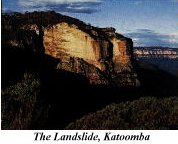
Text & Photos – Copyright © 1997
National Parks & Wildlife Service NSW
For millions of years the elements and the global forces have shaped and reshaped the Blue Mountains. Through geological time the basement rocks of the mountains were submerged by marine foreland basins overgrown by peaty bogs, kilometres thick in some places, then buried underneath deep deposits of sand brought by huge braided river systems.
Past volcanic activity can be observed in the form of basalt caps on the higher peaks (such as Mt Banks and Mt Wilson). Eroded basins have formed on the diatremes where stream superheated by the earths core once blasted its way through to the surface.
The continental drift forced the crumpling of the Australian coastline, pushing up the mountains that are the Great Dividing Range.
More recently plutons of granite, swelling up from the molten core of the earth lifted and tilted the Blue Mountains , forcing slow running streams to flow more quickly. The swift flow of water has cut deeply into the sandstones, carving great valleys canyons and gorges. The depths of the valleys reveal the granites under the quartzite and conglomerate rocks twisted and folded by heat and pressure.
Giant vertical cliffs , etched and cracked by fault lines surround the valleys. The deep valleys and dissected cliff-lines are the core of the Blue Mountains environment and provide the basis for the astounding diversity of plant and animal species living in the area.
National Parks & Wildlife Service, National Park Shop and Information,
Heritage Centre, End of Govetts Leap Road, Blackheath.
Phone: +61 (02) 4787 8877.
Open 9am to 4.15pm every day except Christmas Day



